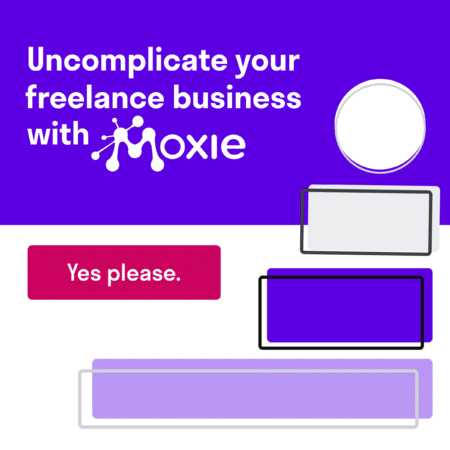Here’s an idea: people – including clients – are generally not bad, bitter, or overall evil. It’s just the circumstance that sometimes result in us – the freelancers – getting screwed during the process.
I really believe this is true, and that there’s just a small number of genuinely crappy people out there who go into a business project with pure intention of screwing the other party.
And unfortunately, there’s hardly any protection from those people.
I mean, if someone wants to cheat you out of your money, they will, in spite of a contract being in place or any other line of safety you’ve set.
So instead of fighting a losing battle, let’s focus on the kind of situations that can be prevented – situations that happen when good people go bad all of a sudden. Let’s try to figure out what habits we can build when working with clients so we don’t get burned on the job.

1. Avoid working for friends and family
Working for friends or family is a touchy subject for most freelancers (and not only designers). In general, we prefer to avoid any sort of such projects. And for a good reason, actually.
First and foremost, I bet you that a “family project” will never be one of your high earners, nor will it be one of your most easy going projects, and probably won’t be the quickest one either.
What’s even worse, it can have a negative impact on your personal relationship with the person you’re helping.
When you look at it, it’s hard to put a finger on any advantage of working for a family member or a friend whatsoever. I really do advise to avoid this type of work altogether.
But immediately, there’s a problem. You can’t just say no, can you?
That is an obstacle, but there is a sneaky way out. For instance, point at your busy schedule, say that you can’t fit another project at the moment and tell the person that you can recommend a couple of other people who will be able to handle it just as well as you would.
In most of the cases, this solves the problem entirely.

However, if the above is not an option for you (maybe it’s your mom asking you for help, or a really close friend) then – wait for it – just agree to do the project for free. I know that this sort of advice might not sit well with you at first, but hear me out.
You might be thinking that some money is always better than no money, right? Well, not always, and working for family is one of those situations.
Dan Ariely – a psychology and behavioral economics professor – writes in “Predictably Irrational” that as soon as any amount of money gets introduced into a given scenario, the mindsets of the people taking part change as well, from personal to business-centered.
Even if the amount is small, which it will probably be when working for family, the “client” is still likely to demand a certain way of handling the project. And since you’re not making much money anyway, you don’t want people making demands. In fact, them owning you a favor is much more valuable than any small monetary reward.
Ariely also mentions a clever phrase you can use when someone wants to at least give you some money. Just say (and I’m paraphrasing):
I’m doing this for free because if I took money, I’d have to charge you more than you can afford.
2. Don’t send the final build until you get paid
If you’ve been following other bits of advice we’re sharing here on Millo then you know that you should always take at least 50 percent of the money up front. In case things go really bad and the client vanishes completely, you at least have half of the money with you.
Now, the only question here is when should you ask for the other half?

And the safest answer is: just before delivering the final build. This saves you from a situation where the client gets the work done but you don’t get the money.
The way to do it is to showcase the results of your work on a server owned and controlled by you, and then roll it out to the client’s server only when you have the full amount with you. If the client is honest then they will have absolutely no problem with things being handled that way. After all, they just want to see what they’re paying for, so a test server will be okay.
When you think about it, it’s actually how buying things at the store works. You can check out a given item on the shelf, but if you want to take it home, you need to pay.
3. When you smell trouble, scare them off with your rates
Simply saying no to a client isn’t always the best solution. Clients are just like 10th-graders – they don’t handle break up well.
Although what I advise is a bit cunning, it does work on more than one level, so feel free to take it or leave it. Here’s the deal. Whenever you smell something fishy, like seeing a big red flag, or maybe you simply don’t like the client on a personal level, or whatever else, just double your rates.
The end. That’s the whole trick.
And here are two reasons why it works:
- If the client says that it’s too much then it’s mission accomplished for you because you don’t have to deal with them anymore.
- If the client agrees then it’s mission accomplished for you as well because you get to work at twice your usual rate, which should be more than enough to get you through the project. And if you are using the 50/50 payment split then you basically get the whole amount of the money that you’d normally ask for right up front, hence getting cheated won’t really take place even if the client vanishes later on.
4. Educate them on everything they need to know
Most client problems are a result of certain situations and scenarios taking place that haven’t been explained beforehand. The client expects one thing, another thing happens, so the client hesitates to pay. Simple. And it actually makes sense.

For example, just imagine you going to a mechanic with your car. You ask the mechanic to do one thing, they do something else. Would you pay?
Now, the main issue here is that you can never know for sure what the client expects and how savvy they are about the way websites and web design/dev projects work. That’s why you need to address every important stage of the project before you get to work. And then, what’s even more important, educate them on the solution you’re building as you’re going along.
Finally, sharing a short quick-start guide or pointing them to beginner tutorial videos on YouTube can really do a lot in terms of client satisfaction. Doing some one-on-one training with the client is also a great idea.
In the end, if the client understands how their new site works, they are much more likely to pay what you’re asking for.
5. Make it clear that there’s a guarantee and support
A very common thing clients do is delaying the final payment until every, even the smallest detail on the site is just perfect. They don’t want to pay sooner simply because they are afraid that it’s you who might vanish the day you get the money, so they won’t be able to get anything fixed after that.
Their worries are surely valid because this is basically how things work in almost every industry.
To get over this, offer a guarantee and a reasonable period of free support. As part of the guarantee, you can offer to fix certain issues free of charge for the next X months. If this is written in the contract clearly and in an understandable way, you can point the client to this clause whenever they’re late with the payments (but happy to send you yet another list of fixes).
You will still have to handle those fixes later on, but you will at least get paid.
Prevent, don’t fix
Fixing a bad client situation is always more difficult than preventing one in the first place. You’ve surely noticed that this post was a bit different from the first one. Instead of listing some red flags that are likely to occur when the client is just about to cheat you, we’re focusing more on putting some things in place that can prevent such situations from ever happening.
Again, this won’t be effective 100 percent of the time, but remembering about handling the above will always improve your chances of getting through a project smoothly, and getting paid at the end of it.
How do you prevent getting cheated by a client? Share your thoughts in the comments.
Keep the conversation going...
Over 10,000 of us are having daily conversations over in our free Facebook group and we'd love to see you there. Join us!


What do you do if the client states ” I did not make any money from your work”, so I will pay you half.
Hi, I’m an interior designer and this list is as applicable to our trade as well. It’s consoling, but not the least heartening, to know that these are globally common experiences. Most people out there behave well socially but they’re different when it comes to money matters.
When it comes to interior design of private projects, people tend to go overboard and cross budget limits easily, often choosing not to pay heed to their designer’s alerts. As if by premeditation, such clients invariably want to compensate for their extra expenditure later by shortchanging service providers towards the end of the project. Interestingly, these very same clients pay upfront (and without hesitation) to vendors of commodities and physical products!
The was so good, oh my gosh.The other day I did a project for my brother in-laws friend and I couldn’t charge them the price I wanted because of the family pressure. But now I know better. Stick to my guns take it or leave it.
This is brilliant!!
As proud designers, we can’t help but gain emotional connections with our projects.
When iv’e asked for a small amount from (distant) friends, it’s ruined the friendship 9 times out of 10.
When iv’e worked for Free, they feel like they’re pushing the favour therefore the control remains with me 🙂
This happened to all of us at least once. Like I said, money and friends/family just don’t go well together. 🙂
Great post! On point 1. Avoid working with friends and family. I did notice a huge difference for the projects I did for free vs the ones where I charged. The one project I did for free, in the end, they gave me extra money after the project was over. However, the paid projects I’m doing for a friend has caused some concerns so far with them not having a hard deadline and thus prolonging the project.
For some reason, money and family just don’t go well together. 🙂
Great blog post! I like how working with friends and family is at the top of the list. I think working for friends or family is a no no, no matter what career you are in. I have some photographer friends and people expect them to come out and do what they do for a living for free because it is family. Same with my mechanic friends they are always getting people asking for help, or a quick favour.
Also with difficult clients, if you double your rates and they still want you, then bonus. How cool would that be if you could double your rates all the time, and noone blink an eye. lol
Photographers probably have it the worst in the “working for family” department. Being a website designer is nothing compared to it. 🙂
always put a pass word to the file can only view not print or send a low resolution image for preview
Great list! I’ve had to learn most of these the hard way — particularly about working with family and getting paid BEFORE delivering the final project — but I had never thought of number 3. Because you’re right. There are some clients who you can tell will be a handful from the very beginning. Doubling my rates would be a win for me no matter the outcome, and I’ll keep that strategy in my back pocket for next time. In fact, I’m sitting here wishing I’d employed that tactic just this past week!
Thanks!
I’d say that doubling your rates is the most polite way of saying ‘no’ to a client. Not the most honest one, but still.
We have all had to learn these things the hard way! This is such a great list, I especially like the suggestion to do work for family and friends for free. Either get paid what you’re worth or not at all.
It’s really important to manage the client’s expectations from the very beginning and lay out exactly how things are going to go, sooner rather than later.
Now, some tips on how to manage their expectations effectively would be appreciated!
Thanks!
Unfortunately that’s the biggest problem with discounts. Once you start giving them left and right, people start thinking that they will always be able to get your work done cheaper.
Great thoughts, Karol.
I absolutely agree that doing a job for free is better than doing it at a discount.
Meeting expectations (item #4) is crucial if you want to have a great experience working with a client, regardless of your concerns about getting cheated. If you stay in touch and inform the client of what to expect along the way (and then deliver it, of course), I’ve found that this helps to avoid misunderstandings, arguments, and slow payments.
Thanks!
You’re right about setting expectations. The one thing clients really don’t like is surprises.